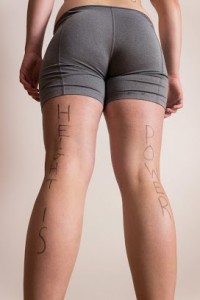Imagine a world in which every college-aged woman comes home from class in the afternoon, looks in the mirror, and thinks to herself “My body looks so strong and beautiful.” The reader will likely recognize how far away this world is from where we are today. 86% of female students surveyed reported the existence of an eating disorder by age 20, and eating disorders claim more lives than any other mental illness in the United States. The main culprit may be what author and speaker Courtney Martin calls the “frightening normalcy of hating your body.” Our society lacks a significant space for body positivity. Fortunately, one area that has the potential to provide this space for young females is women’s athletics—in particular, the sport of rugby.
Loving Your Body is a Statement
Loving one’s body is an inherently political act. Maintaining pride in having a body that is “too big,” “too small,” or “not ideal” is a political statement against the many voices that tell us our bodies are problematic. Mainstream culture normalizes the flawless bodies that dominate every kind of mass media, sending girls the message that only slender, tall bodies are beautiful. At home, girls are taught to cross their legs in public and take up as little physical space as possible. They are taught that being beautiful is much more valuable than being smart and strong (trying weighing Kim Kardashian’s net worth against that of Condoleezza Rice). Magazines preach the gospel of constant diet and exercise to achieve “bikini bodies” that are meant to lounge poolside and be gazed upon. It is a true testament to the misogyny of our culture that women are encouraged to whittle away their bodies and maintain postures that make them as unobtrusive as possible.
Ultimately, it becomes a woman’s responsibility to ensure that she arrives at this standard of beauty. Stand in the checkout line of any grocery store and you will see a plethora of magazines advertising the message that women are supposed to be in a constant state of self-improvement through beauty products, diets, and exercise. Exercise in particular has now taken its place as a piece of the “sexualization” of women phenomenon. Women are bombarded with the idea that the purpose of exercise is to attain a fit body, rather than to improve athletically. Workout videos and programs utilize slogans along the lines of, “receive the flat abs you always wanted,” lending essentially zero value to the practicality of strengthening one’s core muscles.

The Sport of Rugby
Rugby is undoubtedly one of the most physically demanding sports in the world. Lasting 80 minutes long with no substitutions, the amount of physical contact an individual on the field might receive makes American football look like a walk in the park. When most Americans think of rugby, they likely conjure up images of the movie Invictus, of people tackling each other with no protective gear of any kind. What is lesser known about rugby is that it is the only sport that has the exact same rules for men as it does for women. The number of players on the field is the same; unlike basketball, the ball size is the same; and unlike lacrosse, the level of contact is the same.
Rugby is a source of empowerment. Women players are taught to use the strength of their bodies in ways they had never even conceived. Where society appreciates the meek timidity that is supposed to accompany female beauty, rugby encourages women to be a dominating presence—fearless in pursuit of her goals. Contrary to the message that girls grow up receiving, rugby has no ideal body type. The ten separate rugby positions provide every kind of physique the opportunity to play a role on the field—tall, short, broad-shouldered, curvy, thick-legged, tiny. Each girl uses her unique strengths to make a significant contribution to the team. Every body type is celebrated and appreciated. There is no such thing as an ideal rugby body.
It is probable that more than a few girls on our rugby team have struggled with negative body image at some point in their lives. But if you ever had the chance to spend time with our team, you would never know it. We rejoice as a group when a girl proudly declares that she’s gained a few pounds as the result of our weight training. We admire each other’s widening thighs and thickening arms throughout the season. Words cannot adequately describe the liberating feeling that being a part of a team with such body positivity provides. Imagine the relief of taking a breath of fresh air after being drowned for so long in the pressure that society places on women to fit some unrealistic mold. Rugby, and our team in particular, only pressures players to utilize and to be proud of the parts of their bodies that make them unique.
The photo essay that accompanies this article is a testament to the power that a sport like rugby has. It demonstrates that there is the potential out there for women to be proud of their bodies, no matter what. It seeks to infiltrate the media landscape dominated by body negativity by inviting lookers to join us in our celebration of the distinctive beauty of each of our bodies. What you see are girls literally writing the things they love most about a fellow player’s body or personality on that player’s body with sharpie. Although it is extremely difficult to maintain a constant state of positive self-image in our culture, every time a woman celebrates the beauty of her own body or of another woman she is making a political statement. She is saying that she refuses to accept the messages spread by mainstream culture, and she is refusing to accept that her body is only valuable as a visual object.
Photos by Shelby Lin and Lydia Burns

